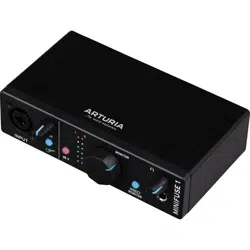Loading ...
Loading ...
Loading ...

8.5. How to deal with latency
There are several ways to effectively deal with latency depending on the situation. Once you
are familiar with the concepts outlined above, you will be able to dynamically adjust your
system settings to accommodate various scenarios.
8.5.1. Recording live audio
When recording live audio from instruments and microphones, you probably want to avoid
latency altogether. The MiniFuse features Direct Monitoring which will route the input(s)
directly through the speakers or headphones. This lets you immediately hear what you’re
recording without incurring any latency from computer processing. Direct Monitoring is
offered as a continuous Monitor Mix knob that you can use to control the balance between
direct signal and computer signal.
When using Direct Monitoring, you may need to turn off monitoring for the recording channel in
your DAW to prevent an echo through the speakers or headphones. Direct monitoring routes the input(s)
directly out of the outputs, so you will not be able to hear any software processing or effects that you
may have applied to the recording channel in your application. For best results, we also recommend
shutting down other CPU-intensive applications while recording live audio.
8.5.2. Recording a MIDI part
Since recording MIDI parts relies on the computer to produce sounds from your playing,
Direct Monitoring is not an option in this scenario. When recording MIDI parts, you will most
likely want to set a low audio buffer size in your host application’s audio settings to minimize
the delay between pressing a key and hearing the sound. We recommend buffer sizes of
128-256 samples but you could go lower or may need to go higher, depending on your
particular computer system and how much CPU your project is using.
8.5.3. Mixing and mastering
Mixing and mastering are not time-critical tasks, so latency is not as important in these
situations. It’s also likely that by this stage your project has quite a few tracks and plugins,
so your CPU may already be working hard to keep up. For mixing and mastering purposes
we recommend buffer sizes of 1024-2048 samples. Again, depending on your specific
system and project you may be able to use lower settings.
Arturia - User Manual MiniFuse 1 - A QUICK PRIMER ON DIGITAL AUDIO 31
Loading ...
Loading ...
Loading ...
